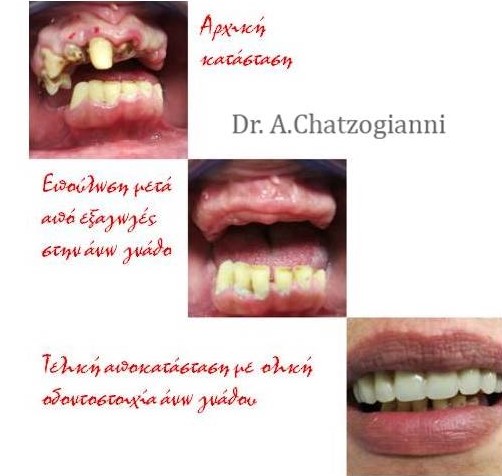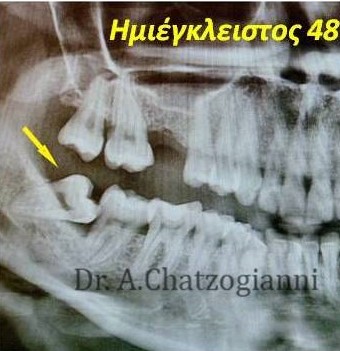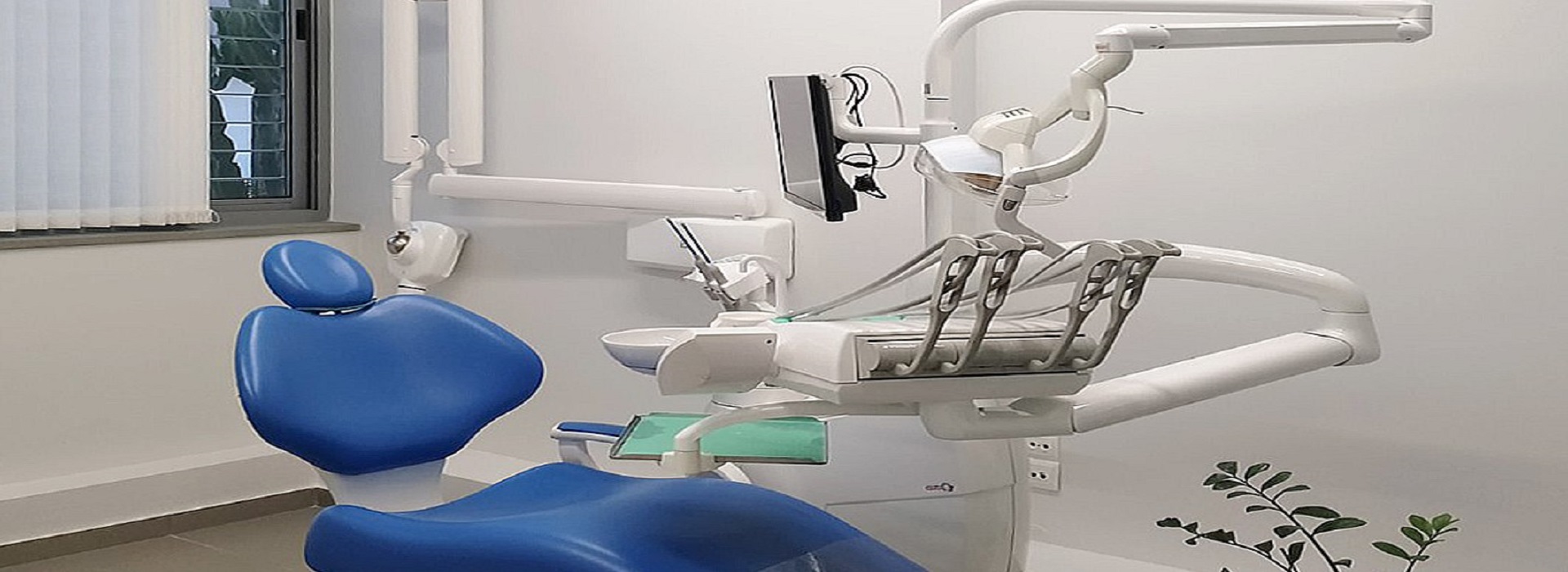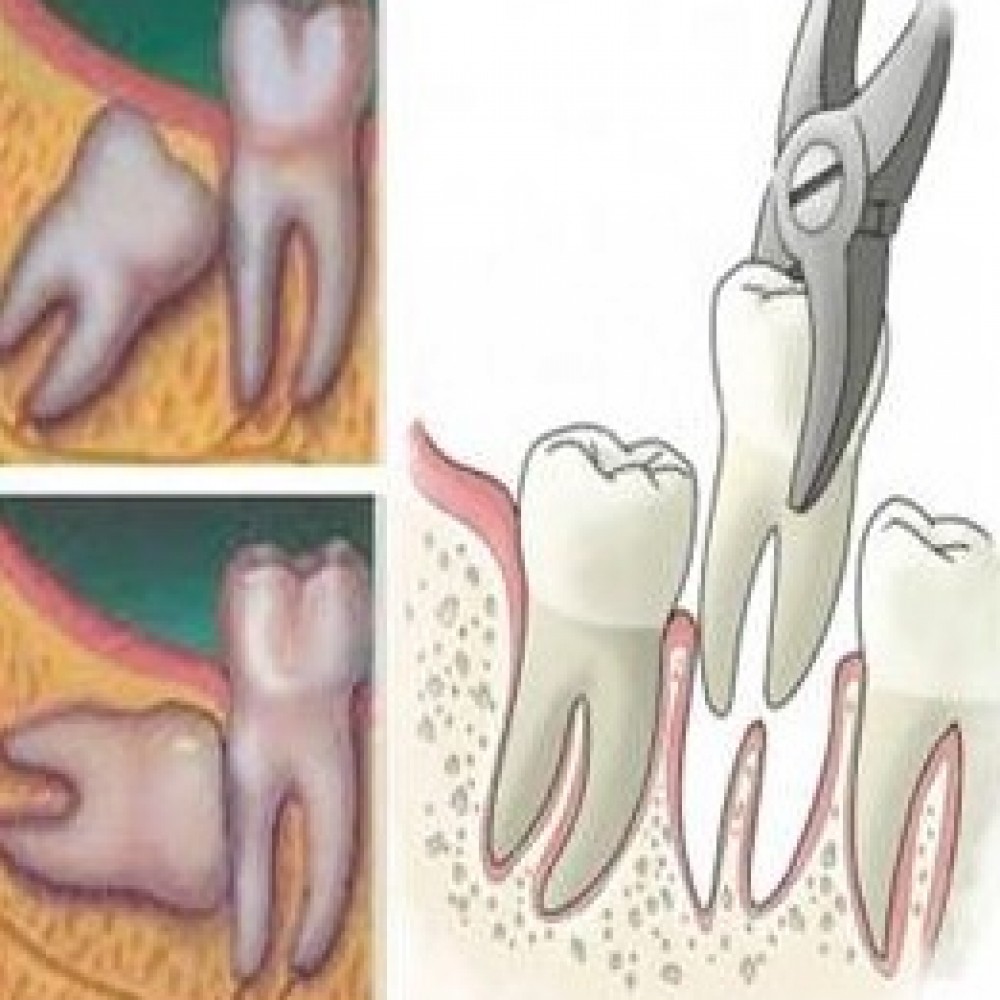Tooth extraction is the removal of one or more teeth from the dentition.
Usually, tooth extraction is performed on damaged teeth from caries, periodontal disease, tooth trauma - especially when a toothache co-exists - on inappropriate teeth growth (e.g. impacted wisdom teeth) and orthodontics (often premolars) to create space, so that the remaining teeth become straight.Tooth extraction is usually a relatively simple procedure and it is performed using local anesthetics. Some teeth are harder to remove for a variety of reasons, such as the tooth position and the shape of the teeth roots.
If a tooth is located inside the bone (e.g. impacted or semi-impacted
wisdom teeth), the extraction may need to be performed surgically, including
the cutting and removing of the bone holding the tooth. After the tooth is
removed, sutures are placed. In this case it is recommended to visit
specialized dental surgeons.
 The most common causes of
tooth extraction:
The most common causes of
tooth extraction:
·
Breaking or
damaging of teeth which can not be treated.
·
Severe caries or
inflammation (acute or chronic alveolus abscess).
·
Numerous teeth
in the dentition which prevent other teeth from rising.
·
Preparation for
an orthodontic treatment (braces) so that the rest of them are straightened.
·
Endodontic treatment failure.
·
Root fracture,
tooth trauma, especially when there a toothache co-exists.
·
Removal in
impacted teeth with an inflammation, bone resorption.
SURGICAL EXTRACTIONS-IMPACTED/SEMI- IMPACTED WISDOM TEETH
The wisdom or third molars, according to medical terminology, are the last teeth of permanent teething that grow and appear in the mouth towards the end of puberty, where the period of adulthood begins and the person matures and gets wise.The man has four teenagers in both jaws. These teeth often cause problems, either with the pain they cause when they rise, or with the complications they can create in cases of erroneous, ectopic east position.
The most common problems caused by wisdom are:
Inflammation of the gums (peristonitis). When the tooth has risen in part, bacteria can penetrate through the space created under the gingival teeth of the tooth and create inflammation in the gums surrounding the wisdom.
Caries. Because the partially ascended wisemen are not easily cleaned, the bacteria contained in the dental plaque can create cavities both on the surface of the wisdom and the adjacent teeth.
Congestion and destruction of the structure of other teeth. When crowded, the teeth lose their right position in the mouth. Good cleaning becomes more difficult and teeth can begin to be unevenly or prematurely destroyed. Wisdomes are often responsible for crowding the front teeth and for the recurrence of orthodontic treatment.
Bladder formation. Sometimes a bladder can be created around a locked wisdom, which can damage adjacent teeth, jaw bone, nerves and other anatomical elements.
Other symptoms that can be observed are tingling, dysphagia, peripheral adenopathy, fever, chills, sensitivity to the skin of the face corresponding to the area, anorexia, pharyngitis and fluid discharge at the mucosal pressure above the tooth that rises, abscess, jaw, while the tear of the semi-closed tooth often begins.
Frequent periodontitis is present in this area, but swelling in the jaw angle and skin fistula can be rarely observed in incisors of the mandible, while the incidence of sinusitis in corresponding teeth with abscess in the maxilla is more common.
In the above cases, it is necessary to remove them. Frontimites that have appeared in the mouth and function, if they do not have the slightest disease and are in a healthy environment with healthy gums, need not be removed.
However, wisdom teeth that are either semi-impacted or impacted and do not participate in chewing, even if they do not pose a problem, should be removed.
 When and how do the wizards be removed?
When and how do the wizards be removed?
The best age for removal of the wisdom is between 16 and 19 years, before the roots get fully groomed and because the jaw bone is softer. As we grow the jaw bones become more compact, making exports more difficult.
The extraction of fully-developed wisdom is usually the same as the simple extraction of any other tooth can be performed either by the general dentist or by the specialized surgeon. Healing is usually very fast and the patient can return to his normal activities immediately. The procedure is simple and is done in the clinic using a local anesthetic.
However, in the case of closed or semi-closed wizards where surgical extraction is required, this must be done only by specialized oral surgeons, or dental surgeons or maxillofacial surgeons, in order to make the procedure as quickly and painlessly as possible for the patient. Surgical extraction is done using a local anesthetic in the clinic and only in rare cases of particular difficulty needs to be done with moods or general anesthesia.
Should the wisdom come out to children and adolescents after orthodontic treatment?
The presence of incurable wisdom, according to many experts, seems to be one of the factors that put pressure on the front teeth resulting in the loss of the results of orthodontic treatment. For this reason, most orthodontists recommend the export of adherent penitentiaries to children and adolescents after the end of orthodontic treatment and, in some cases, at the beginning.
Generally, because wisdom problems develop gradually and there may or may not be symptoms, the best way to avoid problems is to regularly visit our dentist for clinical and radiographic control of the oral cavity. However, there are only a few times when we do not need to export the third molars, as if they are absolutely healthy, germinate completely and can brush them adequately.
EXTRACTION COMPLICATIONS
In the majority of cases, no problems or complications are expected during or after the tooth extraction. But, sometimes, an extraction can show unpredictable complications.
The possible complications of a tooth extraction after surgery include:
· Dry alveolus. The area where the roots are located (alveolus) is infected, its blood supply stops, it begins to deaden and the patient is in a lot of pain. There is violent pain which is sometimes accompanied by stench. It appears 2-3 days after the extraction.
· Infection. There is a possibility that germs may penetrate the wound, especially in patients with an impaired immune system, or when postoperative instructions are not properly followed. In the event of a high risk of infection, the dentist will prescribe antibiotics for both before and after the extraction.
· Excessive bleeding and / or swelling, redness or fever.
· Nerve damage and numbness in the lower lip or tongue
· Pain. It is common after an extraction and especially after difficult surgeries. Analgesics are taken, according to the dentist’s instructions.
To avoid all of the above, the dentist’s instructions must be followed before, after and during the procedure.The greater the difficulty of an extraction, the more likely the occurrence of complications during or after surgery, so it is preferable to consult dentists with a specialization in this field.


